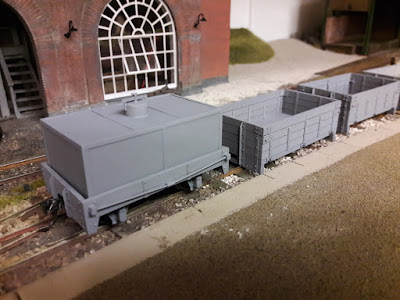Wagons
Cassettes
The workshop was a hive of industry this week. Stephen and Geoff first discussed progress with their two sets of wagons, explaining minor issues and workarounds with the various components. The general appearance was very encouraging.
Following discussions in the week, Kadee couplings and Peco Hardlon bearings had been ordered. However, Geoff confirmed Stephen's suspicions that the all-plastic Peco 'Wonderful wagon' wheels had been discontinued and explained it was due to standard axle lengths being lengthened. This resulted in basic Hornby wheels being ordered with a view to replacing the steel axles with 'homemade' brass alternatives. (The steel axles get attracted by the Kadee under-track magnets, which we're trying to avoid.) Fortunately, everything arrived at lunchtime.
A small discrepancy in the underframe jig had produced a few very slightly higher bodies that will simply require additional shims to keep the couplings at the correct level. Geoff had already adjusted the jig ready for the remainder of the wagons. Stephen used the corrected jig to assemble enough underframes to finish his wagons.
Geoff also had a session turning brass axles and swapping them for the steel axles in the Hornby wheel sets. (These will enable Stephen to progress his wagons in the week.)
This also enabled Geoff to assemble his first production wagon.
As well as keeping an eye on the wagon developments, Laurence progressed his work on the cassettes. Having completed the pair of jigs (or did he say fixtures?) he drilled holes in one end of a cassette.
He then cut a batch of MDF blocks, drilled holes and fitted 3mm brass pins in the first wooden block.
Following initial tests, discussions ensued about ease of inserting the blocks, their stability, future wearing of the holes etc. Damage to the end couplings of free-running stock was also discussed producing options for wooden blocks either side of the coupling knuckle or foam pads. All-in-all it was considered a job well done albeit another running session is now required to test them fully.











































